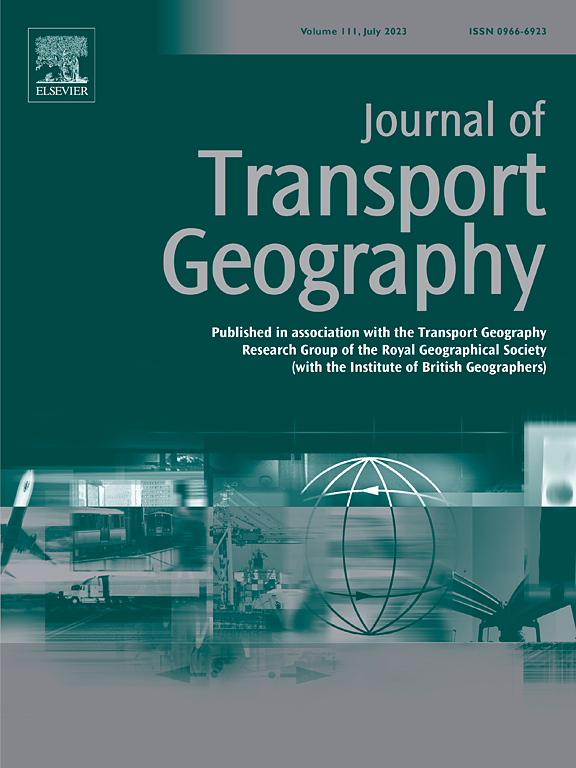评估街道网络空间可达性的适应性中心性指数:在巴西两个中等城市的应用
IF 5.7
2区 工程技术
Q1 ECONOMICS
引用次数: 0
摘要
本文探讨了一种基于网络的评估城市街道网络空间可达性的改良方法:潜在可达性(PA)指数。在网络中心度量法的基础上,结合交通和地理学研究的概念,该指数将有限容量机会的空间竞争整合到一个有向、加权的网络模型中。PA 指数考虑了供给(如就业机会)和需求(如人口)属性,以及它们在全局分析或局部分析(预定义的集水半径)中的空间相互作用。为了证明 PA 指数的特性和实用性,我们将其应用于巴西的两个中等城市,分析正规就业机会的可及性。我们进行了四项实验:非加权分析、供应加权分析、基于竞争的供需加权分析以及以 1600 米为半径的本地可达性分析。第五项实验将 PA 指数与 "到达中心度"(一种基于网络的非竞争性可达性测量方法)进行了比较。结果揭示了街道网络配置的变化如何影响可达性结果和不平等模式,并使用帕尔马比率进行捕捉。与 "到达 "指数相比,PA 指数能更有效地区分本地和全球的可达性,并能更好地揭示竞争和邻近性是如何影响机会获取的。该方法具有灵活性,可进行多区分析、社会属性整合和情景模拟,支持旨在实现公平获取服务的规划应用。这项研究引入了一个基于网络的框架,有可能加强以邻近性为中心的地方无障碍城市政策,特别是与中小城市相关的政策,从而为无障碍研究做出了贡献。本文章由计算机程序翻译,如有差异,请以英文原文为准。
An adapted centrality index to assess spatial accessibility in street networks: Application to two medium-sized cities in Brazil
This paper explores an adapted network-based measure for assessing spatial accessibility in urban street networks: the Potential Accessibility (PA) index. Building upon network centrality measures and incorporating concepts from transportation and geography studies, the proposed index integrates spatial competition for limited-capacity opportunities into a directed, weighted network model. The PA index accounts for both supply (e.g., employment opportunities) and demand (e.g., population) attributes, and their spatial interaction within a global analysis or a local one (with a predefined catchment radius). To demonstrate the PA index's properties and practical relevance, we apply it to two medium-sized Brazilian cities, analyzing accessibility to formal employment opportunities. We conducted four experiments: an unweighted analysis, a supply-weighted analysis, a competition-based analysis with both supply and demand weights, and a local accessibility analysis using a 1600-m radius. A fifth experiment compares the PA index to Reach centrality, a non-competitive network-based accessibility measure. Results reveal how variations in street network configuration influence accessibility outcomes and inequality patterns, captured using the Palma Ratio. The PA index distinguishes local from global accessibility more effectively than the Reach index and better reveals how competition and proximity affect opportunity access. The method's flexibility allows for multiscalar analysis, integration of social attributes, and scenario simulations, supporting planning applications aimed at equitable access to services. The study contributes to accessibility research especially by introducing a network-based framework with the potential to enhance proximity-centered and local accessibility urban policies, particularly relevant to small and medium-sized cities.
求助全文
通过发布文献求助,成功后即可免费获取论文全文。
去求助
来源期刊

Journal of Transport Geography
Multiple-
CiteScore
11.50
自引率
11.50%
发文量
197
期刊介绍:
A major resurgence has occurred in transport geography in the wake of political and policy changes, huge transport infrastructure projects and responses to urban traffic congestion. The Journal of Transport Geography provides a central focus for developments in this rapidly expanding sub-discipline.
 求助内容:
求助内容: 应助结果提醒方式:
应助结果提醒方式:


